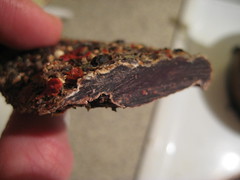easy charcuterie: dry-cured duck breast
 Do you like cured hams? I like cured hams. Prosciutto, Serrano, Bayonne. Salty, sweet, funky hams. Unfortunately for the home charcutier, a good aged ham requires about a 20 pound hog leg and at least six months of time - not to mention a climate controlled drying chamber. However, one can apply the same concept to a simple boneless duck breast, either wild or farm raised. Duck meat, especially the breast, has an exquisite earthy sweetness that shines after a good curing.
Do you like cured hams? I like cured hams. Prosciutto, Serrano, Bayonne. Salty, sweet, funky hams. Unfortunately for the home charcutier, a good aged ham requires about a 20 pound hog leg and at least six months of time - not to mention a climate controlled drying chamber. However, one can apply the same concept to a simple boneless duck breast, either wild or farm raised. Duck meat, especially the breast, has an exquisite earthy sweetness that shines after a good curing.
Several years ago I stumbled across a very simple cured duck breast recipe in Mario Batali's Babbo cookbook. Just pat it dry, roll it in salt and spices, and hang for about 10 days. I've been waiting for a surplus of duck to use for this recipe, but I only hunt waterfowl a few days per season, so I've never had more than one or two birds to eat. This year the waterfowl hunting gods blessed me with a very fast morning, so it seemed like a good time to cure some duck. The results were quite tasty.
I'm guessing wild goose would work equally well, perhaps even better given its larger size and thickness. In fact, Hank Shaw has a tantalizing recipe for this on his fantastic wild cookery blog.
Recipe: Dry-Cured Wild Duck Breast
Ingredients
- 2 split wild duck breast (4 pieces)
- 4 tablespoons kosher salt
- 3 tablespoons freshly ground black pepper
- 1 tablespoon sugar
- 1 tablespoon hot red pepper flakes (use less if you can't handle heat)
- 1 tablespoon chopped thyme leaves
- In a small bowl, combie the salt, pepper, sugar, red pepper flakes, and thyme. Coat the duck breast with this mixture, wrap it loosely in wax paper and refrigerate for 2-3 days.
- Unwrap, wipe off most of the seasoning. Punch a small hole on one end of the breast and tie a length of twine long enough to hang from your cool basement ceiling or refrigerator shelf.
- Hang the breast in a cool, dark, semi-humid place (an unfinished basement in winter works well) for 1-2 weeks, or until the breast shrinks to nearly half its original size and feels quite firm to the touch. When sliced, the breast should be wine colored and have a nice, hammy chew.
